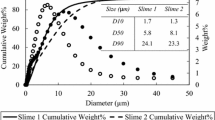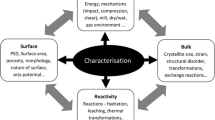Abstract
An approximate analytic model is developed for minerals liberation when comminution processes are applied to multi-component ores, i.e., ores that include grains of multiple mineral species. The model employs a one-dimensional representation of ore texture similar to that employed by King (1979) and Klimpel and Austin (1983). The spatial texture representation is viewed as being generated by a stationary semi-Markov process. Associated semi-regenerative processes are defined that can be used to establish, approximately, the joint distribution of particle size and composition, where composition refers to the identities and relative proportions of mineral species included within the particle. Numerical predictions made by the model are compared to size and composition distributions observed in previous experimental studies.
Similar content being viewed by others
References
Bagga, P.S., and Luckie, P.T., 1983, “A Monte-Carlo Simulation of Liberation,” Proceedings, First Conference on Use of Computers in the Coal Industry, Y.J. Wang and R.L. Sanford, eds., AIME, New York, NY, 247–250.
Barbery, G., 1987, “Random Sets and Integral Geometry in Comminution and Liberation of Minerals,” Minerals and Metallurgical Processing, Vol. 4, No. 2, pp 96–102.
Barbery, G., and Leroux, D., 1988, “Prediction of Particle Composition Distribution after Fragmentation of Heterogenous Materials,” International Journal of Mineral Processing, Vol. 22, pp. 9–24.
Cinlar, E., 1975, Introduction to Stochastic Processes, Prentice Hall, Englewood Cliffs, NJ.
Davy, P.J., 1984, “Probability Models for Liberation,” J. Appl. Prob., Vol. 21, pp. 260–269.
King, R.P., 1979, “A Model for the Quantitative Estimation of Mineral Liberation by Grinding,” International Journal of Mineral Processing, Vol. 6, pp 207–220.
Klimpel, R.R., 1984, “Applications of a Model for the Analysis of Liberation from a Binary System,” Powder Technology, Vol. 39. pp. 117–128.
Klimpel, R.R., and Austin, L.B., 1983, “A Preliminary Model of Liberation from a Binary System,” Powder Technology, Vol. 34, pp. 121–130.
Ross, S., 1983, Stochastic Processes, Wiley, New York.
Author information
Authors and Affiliations
Additional information
M&MP paper 90-638.
Discussion of this paper must be submitted, in duplicate, prior to Aug. 30, 1991.
Rights and permissions
About this article
Cite this article
Yingling, J.C. Liberation model for multi-component ores. Mining, Metallurgy & Exploration 8, 65–72 (1991). https://doi.org/10.1007/BF03402934
Received:
Published:
Issue Date:
DOI: https://doi.org/10.1007/BF03402934




